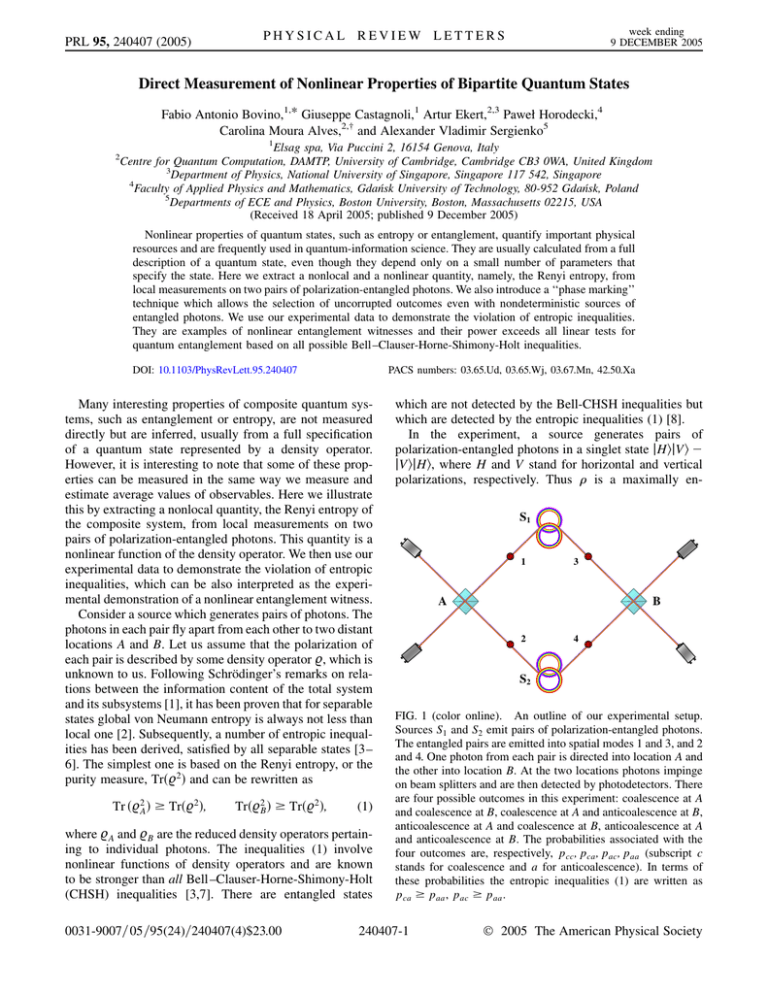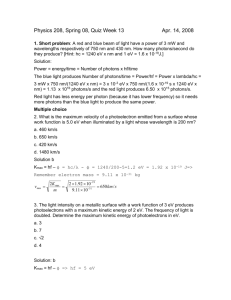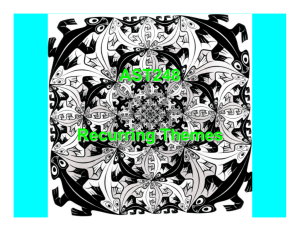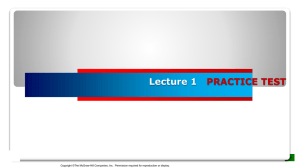Direct Measurement of Nonlinear Properties of Bipartite Quantum States
advertisement

PRL 95, 240407 (2005) week ending 9 DECEMBER 2005 PHYSICAL REVIEW LETTERS Direct Measurement of Nonlinear Properties of Bipartite Quantum States Fabio Antonio Bovino,1,* Giuseppe Castagnoli,1 Artur Ekert,2,3 Paweł Horodecki,4 Carolina Moura Alves,2,† and Alexander Vladimir Sergienko5 2 1 Elsag spa, Via Puccini 2, 16154 Genova, Italy Centre for Quantum Computation, DAMTP, University of Cambridge, Cambridge CB3 0WA, United Kingdom 3 Department of Physics, National University of Singapore, Singapore 117 542, Singapore 4 Faculty of Applied Physics and Mathematics, Gdańsk University of Technology, 80-952 Gdańsk, Poland 5 Departments of ECE and Physics, Boston University, Boston, Massachusetts 02215, USA (Received 18 April 2005; published 9 December 2005) Nonlinear properties of quantum states, such as entropy or entanglement, quantify important physical resources and are frequently used in quantum-information science. They are usually calculated from a full description of a quantum state, even though they depend only on a small number of parameters that specify the state. Here we extract a nonlocal and a nonlinear quantity, namely, the Renyi entropy, from local measurements on two pairs of polarization-entangled photons. We also introduce a ‘‘phase marking’’ technique which allows the selection of uncorrupted outcomes even with nondeterministic sources of entangled photons. We use our experimental data to demonstrate the violation of entropic inequalities. They are examples of nonlinear entanglement witnesses and their power exceeds all linear tests for quantum entanglement based on all possible Bell –Clauser-Horne-Shimony-Holt inequalities. DOI: 10.1103/PhysRevLett.95.240407 PACS numbers: 03.65.Ud, 03.65.Wj, 03.67.Mn, 42.50.Xa Many interesting properties of composite quantum systems, such as entanglement or entropy, are not measured directly but are inferred, usually from a full specification of a quantum state represented by a density operator. However, it is interesting to note that some of these properties can be measured in the same way we measure and estimate average values of observables. Here we illustrate this by extracting a nonlocal quantity, the Renyi entropy of the composite system, from local measurements on two pairs of polarization-entangled photons. This quantity is a nonlinear function of the density operator. We then use our experimental data to demonstrate the violation of entropic inequalities, which can be also interpreted as the experimental demonstration of a nonlinear entanglement witness. Consider a source which generates pairs of photons. The photons in each pair fly apart from each other to two distant locations A and B. Let us assume that the polarization of each pair is described by some density operator %, which is unknown to us. Following Schrödinger’s remarks on relations between the information content of the total system and its subsystems [1], it has been proven that for separable states global von Neumann entropy is always not less than local one [2]. Subsequently, a number of entropic inequalities has been derived, satisfied by all separable states [3– 6]. The simplest one is based on the Renyi entropy, or the purity measure, Tr%2 and can be rewritten as Tr %2A Tr%2 ; Tr%2B Tr%2 ; (1) where %A and %B are the reduced density operators pertaining to individual photons. The inequalities (1) involve nonlinear functions of density operators and are known to be stronger than all Bell –Clauser-Horne-Shimony-Holt (CHSH) inequalities [3,7]. There are entangled states 0031-9007=05=95(24)=240407(4)$23.00 which are not detected by the Bell-CHSH inequalities but which are detected by the entropic inequalities (1) [8]. In the experiment, a source generates pairs of polarization-entangled photons in a singlet state jHijVi jVijHi, where H and V stand for horizontal and vertical polarizations, respectively. Thus is a maximally enS1 1 3 A B 2 4 S2 FIG. 1 (color online). An outline of our experimental setup. Sources S1 and S2 emit pairs of polarization-entangled photons. The entangled pairs are emitted into spatial modes 1 and 3, and 2 and 4. One photon from each pair is directed into location A and the other into location B. At the two locations photons impinge on beam splitters and are then detected by photodetectors. There are four possible outcomes in this experiment: coalescence at A and coalescence at B, coalescence at A and anticoalescence at B, anticoalescence at A and coalescence at B, anticoalescence at A and anticoalescence at B. The probabilities associated with the four outcomes are, respectively, pcc ; pca ; pac ; paa (subscript c stands for coalescence and a for anticoalescence). In terms of these probabilities the entropic inequalities (1) are written as pca paa , pac paa . 240407-1 © 2005 The American Physical Society PHYSICAL REVIEW LETTERS PRL 95, 240407 (2005) tangled pure state and, consequently, A B are maximally mixed, completely depolarized states. In order to measure a quadratic property of we need to operate on at least two copies of the entangled pairs. Here we use the phenomenon of coalescence and anticoalescence of photons. If two identical photons are incident on two different input ports of a beam splitter they will coalesce, i.e., they will emerge together in one of the two, randomly chosen, output ports. More precisely, all pairs of photons (in general all pairs of bosons) with a symmetric (under the exchange of photons) polarization state will coalesce and all pairs of photons with an antisymmetric polarization state will anticoalesce, i.e., photons will emerge separately in two different output ports of the beam splitter [9,10]. The main idea behind our experiment is illustrated in Fig. 1. Two independent pairs of photons are generated by sources S1 and S2 , one photon from each pair is directed into location A and the other into location B. At the two locations the photons impinge on beam splitters and are then detected by photo detectors. The beam splitters at A and B, as long as the photons from two different pairs arrive within the coherence time, effectively project on the symmetric and antisymmetric subspace in the four dimen- week ending 9 DECEMBER 2005 sional Hilbert space associated with the polarization degrees of freedom. Let us consider the four possible detections in this experiment: coalescence at A and coalescence at B, coalescence at A and anticoalescence at B, anticoalescence at A and coalescence at B, and finally, anticoalescence at A and anticoalescence at B. Let the probabilities associated with the four outcomes be, respectively, pcc ; pca ; pac ; paa , (subscript c stands for coalescence and a for anticoalescence). In technical terms they correspond to probabilities of projecting the state of two pairs of photons on symmetric or antisymmetric subspaces at location A (associated with spatial modes 1 and 2) and B (associated with spatial modes 3 and 4), e.g., pca TrPS PA etc., where PS and PA are the corresponding projectors on the symmetric and antisymmetric subspaces. We can now write Tr %2 pcc pca pac paa ; (2) Tr %2A pcc pca pac paa ; (3) Tr %2B pcc pca pac paa ; (4) and the inequalities (1) can be expressed in a new and φ λ FIG. 2 (color online). Experimental setup. Two pairs of polarization-entangled photons are generated in two separate 3 mm-thick BBO crystals via type II SPDC. The crystals are pumped by two beams, each consisting of a train of femtosecond laser pulses (160 fs) with the central wavelength of 415 nm and a repetition rate of 76 MHz. The beams are displaced by a few micrometers using a trombone and the subwavelength path difference (phase shift ) is introduced by a tilted 1 mm-thick quartz plate inserted into one of the pump beams. The two pump beams are obtained by splitting the main beam (average power 470 mW), which is generated by second harmonic generation (SHG) of the output of a Coherent MIRA-VERDI laser. Entangled photons emerging from the BBO crystals enter interferometers which provide high fidelity polarization-entangled states in an ultrafast regime [13]. Subsequently, the photons are sent to the beam splitters BS1 and BS2 , so that each beam splitter receives two photons; one photon from each entangled pair. The photons are coupled in single-mode (SM) fibers [14] and detected by the photodetector (Perkin-Elmer SPCM-AQR-14). Once the correct position of the two beam splitters is established the fourfold coincidence interference patterns are measured. Coincidence counts D1 D2 D3A D4A , D1 D2 D3A D4B , D1 D2 D3B D4A and D1 D2 D3B D4B allow the estimation of the rate of anticoalescence-anticoalescence events, whereas D1 D2 D3A D3B and D1 D2 D4A D4B give the anticoalescencecoalescence rate. 240407-2 PRL 95, 240407 (2005) week ending 9 DECEMBER 2005 PHYSICAL REVIEW LETTERS S1 simple form, pca paa ; pac paa : (5) Theoretical predictions for the singlet state are pcc 3=4, pac pca 0, and paa 1=4. Let us mention in passing that in this particular case a coincidence count at A (B) projects the state of the remaining two photons at B (A) on the singlet state, inducing an entanglement swapping [11]. The polarization-entangled photons are generated using type-II spontaneous parametric down-conversion (SPDC) [12]. An ultraviolet pulse from a pump laser is split into two pulses which are slightly delayed with respect to each other and directed towards two -barium-borate (BBO) crystals. The two BBO crystals correspond to the two sources S1 and S2 . When the pulses pass through the crystals they emit, with some probability, pairs of energydegenerate polarization-entangled photons into modes 1 and 3 (source S1 ), and 2 and 4 (source S2 ). Modes 1 and 2 are coupled by the beam splitter at A and modes 3 and 4 by the beam splitter at B. Behind the beam splitters, singlephoton counting modules register emerging photons. The coalescence and anticoalescence coincidences are recorded (Fig. 2). Currently available sources of entangled photons are probabilistic which creates an additional experimental difficulty. When an UV pulse passes through a BBO crystal it produces a superposition of vacuum, two entangled photons, four entangled photons, etc., A four-photon coincidence in our setup may be caused by two entangled pairs from two different sources but also by four photons from one source and no photons from the other, as shown in Fig. 3; moreover, the three scenarios are equally likely. In order to discriminate unwelcome four-photon coincidences we have used ‘‘phase marking’’—for certain values of the phase difference between the two pumping beams we register only coincidences not corrupted by the spurious emissions. The description can be made more quantitative by analyzing an effective Hamiltonian describing entanglement generation in two coherently pumped BBO crystals, 1 3 A B 2 4 S2 S1 1 3 A B 4 2 S2 S1 1 3 A B 2 4 S2 FIG. 3 (color online). Possible emissions leading to fourphotons coincidences. Parametric down-conversion is not an ideal source of entangled photons. It generates a superposition of vacuum, two-entangled photons, four-entangled photons, etc., The central diagram shows the desired emission of two independent entangled pairs—one by source S1 and one by source S2 . The top and the bottom diagrams show unwelcome emissions of four photons by one of the two sources. Although the three cases are equally likely, we can eliminate contributions of unwelcome emissions by a judicious choice of the phase difference between the beams that coherently pump the two BBO crystals. We call it ‘‘phase marking.’’ Symmetric superposition of the unwelcome emissions, obtained for 0, does not contribute to the coalescence-anticoalescence events, whereas the antisymmetric superposition, obtained for =2 does not affect the anticoalescence-anticoalescence outcomes. between the beams introduced by the tilted quartz plate, and K a1H a3V a1V a3H and L a2H a4V a2V a4H are the linear combination of annihilation operators describing H K K y Lei Ly ei : (6) the down-converted modes. The subscripts 1, 2, 3, and 4 label the spatial modes and H, V stand for horizontal and Here is a coupling constant, proportional to the amvertical polarizations. The four-photon term of a quantum plitude of the pumping beams, is the relative phase shift state generated by this Hamiltonian can be written as i e 1 1 y2 y2 1 y2 y2 y y y y y y y y y y y y ji p a1H a3V a1V a3H a2H a4V a2V a4H p a1H a3V a1H a1V a3V a3H a1V a3H 2 10 10 2 2i e 1 1 y2 y2 y2 y y y y p ay2 (7) 2H a4V a2H a2V a4V a4H a2V a4H jvaci; 2 10 2 where the first term describes the desired two polarization-entangled pairs, each in the singlet state jHijVi jVijHi, whereas the last two terms describe unwelcome four-photon states generated by an emission from only one of the two crystals (see Fig. 3). The coalescence and anticoalescence coincidences for the state (7) are given by pac pca 3 1 cos2; 20 240407-3 1 3 paa cos2: 4 20 (8) PRL 95, 240407 (2005) PHYSICAL REVIEW LETTERS FIG. 4 (color online). Four-photon coincidences. The plot shows the four-photon interferences as a function of the pump displacement which is proportional to the relative phase shift of the two pumps. The probability of coalescence and anticoalescence for the ideal singlet state case can be extracted from the coincidence counts at the minima of interference curves using (8). The minima of the curves correspond to the required values of pac and paa . The experimental data show that paa > pac , which violates the entropic inequalities (1). The results for the curve anticoalescence-coalescence are normalized by a factor of 2 to take into account the fact that half of the coincidences are lost. In order to recover the coincidences associated with the desired singlet state we notice that for 0 and =2 there are no spurious contributions to pac pca and paa , respectively. For these two phase settings the symmetric and antisymmetric superposition of the last two terms in (7) leads to additional symmetries at the input of the beam splitters and cancels out the unwelcome outcomes. In the experiment we have traced the dependence of pac and paa . Even though the measurement of pac pca and paa could only be realized for different values of the phase , the difference in probability values is clearly observed by following the minima of both curves in Fig. 4. Based on the statistical fit of curves in Fig. 4 we obtain pac pca 0:0255 0:008 and paa 0:2585 0:008. The measured result is in good agreement with the theoretical prediction and clearly demonstrates the violation of the entropic inequalities for the singlet state. Let us stress that these inequalities involve nonlinear functions of a quantum state. Their power exceeds all linear tests such as the Bell-CHSH inequalities with all possible settings and entanglement witnesses. In fact our result can be viewed as the first experimental measurement of a nonlinear entanglement witness. Direct measurements of nonlinear properties of quantum states open new ways of probing and manipulating quantum phenomena. The experiment has been carried out in the Quantum Optics Laboratory of ELSAG spa, Genova, Italy, within the week ending 9 DECEMBER 2005 project ‘‘Quantum Cryptographic Key Distribution’’ cofunded by the Italian Ministry of Education, University and Research (MIUR), Grant No. 67679/L.488 and ECFET Project No. QAP-2005-015848. This work has been also supported by the Cambridge-MIT Institute, the Fujitsu Laboratories Europe, and the European Commission (Project RESQ No. IST-2001-37559). A. E. acknowledges financial support of the A*Star Grant No. 012-104-0040. P. H. acknowledges support from the Polish Ministry of Scientific Research, Information and Technology (Project No. PBZ-Min-008/P03/03). C. M. A. is supported by the Fundação para a Ciência e Tecnologia (Portugal). A. V. S. acknowledges support by the National Science Foundation (NSF) and by the Defense Advanced Research Project Agency (DARPA). F. A. B. acknowledges the help of Mr. Tarantino and the machine shop at ELSAG spa. *Electronic address: Fabio.Bovino@elsag.it † Electronic address: carolina.mouraalves@qubit.org [1] E. Schrödinger, Die Naturewissenschaften 23, 807 (1935). [2] R. Horodecki and P. Horodecki, Phys. Lett. A 194, 147 (1994). [3] R. Horodecki, P. Horodecki, and M. Horodecki, Phys. Lett. A 210, 377 (1996). [4] N. J. Cerf and C. Adami, Phys. Rev. Lett. 79, 5194 (1997). [5] B. M. Terhal, J. Theor. Comput. Sci. 287, 313 (2002). [6] K. G. H. Vollbrecht and M. M. Wolf, J. Math. Phys. (N.Y.) 43, 4299 (2002). [7] J. F. Clauser, M. A. Horne, A. Shimony, and R. A. Holt, Phys. Rev. Lett. 23, 880 (1969). [8] For example, if we mix the maximally entangled singlet state with the maximally depolarized state, in proportions p and 1 p, respectively, (0 p 1), then the resulting state is entangled for p > 13 . However, the entanglement is detected by the CHSH inequalities for p > p12 0:707 107 and by the nonlinear inequalities for p > p13 0:57 735. [9] C. K. Hong, Z. Y. Ou and L. Mandel, Phys. Rev. Lett. 59, 2044 (1987). [10] G. Di Giuseppe, M. Atature, M. D. Shaw, A. V. Sergienko, B. E. A. Saleh, M. C. Teich, A. J. Miller, S. W. Nam, and J. Martinis, Phys. Rev. A 68, 063817 (2003). [11] J.-W. Pan, D. Bouwmeester, H. Weinfurter, and A. Zeilinger, Phys. Rev. Lett. 80, 3891 (1998). [12] P. G. Kwiat, K. Mattle, H. Weintfurter, A. Zeilinger, A. V. Sergienko, and Y. H. Shih, Phys. Rev. Lett. 75, 4337 (1995). [13] Y. H. Kim, S. P. Kulik, M. V. Chekhova, W. P. Grice, and Y. H. Shih, Phys. Rev. A 67, 010301(R) (2003); F. A. Bovino, G. Castagnoli, I. P. Degiovanni, and S. Castelletto, Phys. Rev. Lett. 92, 060404 (2004). [14] F. A. Bovino, P. Varisco, A. M. Colla, G. Castagnoli, G. Di Giuseppe, and A. V. Sergienko, Opt. Commun. 227, 343 (2003). 240407-4




